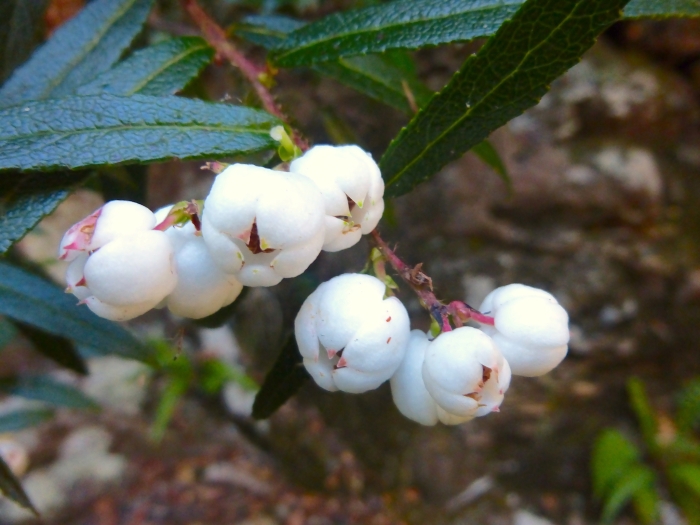Copperleaf Snowberry
(Gaultheria hispida)
Copperleaf Snowberry (Gaultheria hispida)
/
/

Kiri Bee
CC BY 4.0
Image By:
Kiri Bee
Recorded By:
Copyright:
CC BY 4.0
Copyright Notice:
Photo by: Kiri Bee | License Type: CC BY 4.0 | License URL: http://creativecommons.org/licenses/by/4.0/ | Rights Holder: Kiri Bee | Publisher: iNaturalist | Date Created: 2018-02-03T22:54:17-08:00 |
















Estimated Native Range
Summary
Gaultheria hispida, commonly known as copperleaf snowberry, is an erect multi-branched shrub endemic to the cool temperate rainforests, wet sclerophyll forests, and alpine woodlands of Tasmania, Australia. It is typically found at elevations between 820-3609 feet (250-1100 meters). This shrub can grow up to 7 feet tall in sheltered forest sites but remains smaller in exposed alpine conditions. The plant features dark green glossy leaves with copper-tinged serrated edges, and its stems are red, providing a striking contrast. Small, white, urn-shaped flowers appear at the apex of the stems from spring to summer, and these are followed by distinctive snowy white sepals that enclose reddish fruit in autumn. The flowers are modest in size but can add a delicate texture to the garden.
Copperleaf snowberry is valued for its unique foliage and stem coloration, as well as its adaptability to a range of moist, well-drained soils. It is used in garden borders, as an understory plant in woodland gardens, and for naturalizing in areas that mimic its native habitat. While it prefers moist conditions, it is relatively low maintenance once established. The fruit is not widely recognized for culinary use due to its bitter taste, but it was historically collected by Tasmanian Aboriginal People. In cultivation, it requires protection from strong winds and benefits from mulching to maintain soil moisture. Potential problems include susceptibility to root rot in poorly drained soils and foliar diseases in humid conditions.CC BY-SA 4.0
Copperleaf snowberry is valued for its unique foliage and stem coloration, as well as its adaptability to a range of moist, well-drained soils. It is used in garden borders, as an understory plant in woodland gardens, and for naturalizing in areas that mimic its native habitat. While it prefers moist conditions, it is relatively low maintenance once established. The fruit is not widely recognized for culinary use due to its bitter taste, but it was historically collected by Tasmanian Aboriginal People. In cultivation, it requires protection from strong winds and benefits from mulching to maintain soil moisture. Potential problems include susceptibility to root rot in poorly drained soils and foliar diseases in humid conditions.CC BY-SA 4.0
Plant Description
- Plant Type: Shrub
- Height: 1-3 feet
- Width: 1-3 feet
- Growth Rate: Moderate
- Flower Color: White
- Flowering Season: Spring, Summer
- Leaf Retention: Evergreen
Growth Requirements
- Sun: Full Sun, Part Shade
- Water: Medium
- Drainage: Medium, Fast
Common Uses
Border Plant, Low Maintenance
Natural Habitat
Cool temperate rainforests, wet sclerophyll forests, and alpine woodlands of Tasmania, Australia
Other Names
Common Names: Alpine Waxberry
Scientific Names: , Gaultheria hispida, Brossaea hispida,
GBIF Accepted Name: